Feature
Integrated Outdoor and Classroom Science Experiences to Support Civic Engagement Among Middle and High School Students
Connected Science Learning July–August 2023 (Volume 5, Issue 4)
By Missy Holzer, Jessica Monaghan, and Kathleen M. Browne
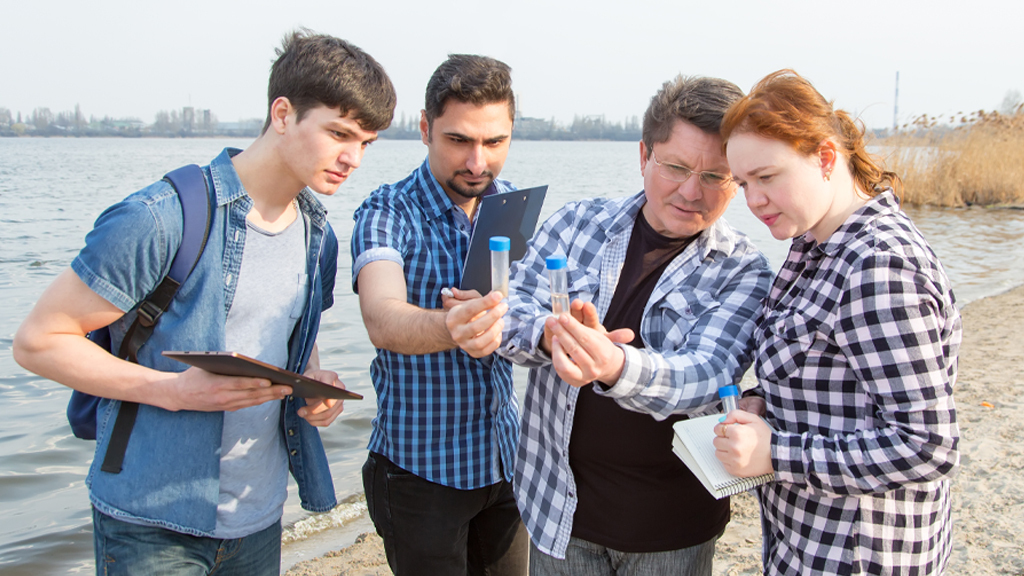
Creating and implementing outdoor science experiences that engage students in civic and socioscientific issues can be very challenging for an individual teacher due to their curricular demands, the inherent logistical complexities of outdoor experiences, and their limited exposure to creating such experiences (Rickinson et al. 2004; Wright et al. 2021). Socioscientific issues (SSIs) integrate relevant social issues, which intersect with concepts of science, along with ethical, economical, and political implications (Sadler et al. 2007). Incorporating SSIs and reasoning in the classroom provides a rich real-world context to deepen learning about the processes and concepts of science among other benefits (Sadler et al. 2007). In addition, focusing discussions of environmental SSIs may enable students to transfer such proficiencies into the “civic sphere” (Michaels et al. 2008) with an action-oriented approach referred to as “civic engagement.” When learning about SSIs is paired with a well-designed outdoor learning experience, anticipated outcomes include motivation, positive impacts on academic performance, and higher-order thinking through experiential learning (Rios and Brewer 2014). A natural intersection for framing SSI in science classrooms is the engineering design process and practices in the Next Generation Science Standards (NGSS) Appendix I - “Engineering Design in the NGSS” (NGSS Lead States 2013). Within the many approaches to the engineering design process, most students take time to define the problem first then work toward designing (and refining) solutions as they consider multiple constraints and perspectives. As students interact with relevant community stakeholders about local SSIs during the engineering design process, they develop a civic identity.
This article describes a successful collaborative project involving five partners who leveraged the outside environment to develop civic connections related to local SSIs. Specifically, a teacher from an urban middle school and a teacher from a suburban high school each worked with different local watershed partners to develop formal-informal educator teams. The central focus for each team was to investigate aspects of sustainability and environmental issues relevant to the students in each of the schools and tied to district curricula, the Next Generation Science Standards (NGSS Lead States 2013), Engineering Design Process (NGSS Lead States 2013), and UN Sustainability Goals (United Nations 2015). A higher-education partner with expertise in the Earth sciences and science education—who had been working with K–12 teachers to implement the NGSS into their districts’ curricula—acted as a fifth partner working directly with the two project teams.
Collaborative Partnerships and Project Beginnings
The teachers and the higher-education partner had each been working to infuse their instruction with civics-related issues to create place-based, locally meaningful learning experiences that challenged their students to identify and create solutions for local issues. These local issues served as phenomena and the context for learning the relevant science content and developing abilities in science and engineering practices. Their efforts were influenced by prior participation in initiatives offered by the National Center for Science and Civic Engagement (NCSCE) and the Science Education for the New Civic Engagement (SENCER) organizations. The project described here came about when a NCSCE grant opportunity surfaced that would serendipitously meet similar longstanding goals among the five partners. The Partnership Champions: SENCER-ISE and Professional Development Through Mentoring to Enhance Learning Environments provided sub-awards to several collaborative cross-sector partnership projects, which in this case included formal and informal settings. The granting staff provided coaching about effective partnerships and project management. This article describes the iterative process used during the project to develop and implement place-based curricula grounded in SSIs. It also provides relevant takeaways for others considering cross-sector educational collaborations.
Critical to the success of this project was the collaborative partnerships that were carefully formed. Of the five project partners, most knew each other through their various networks and other projects. Each had a vested interest in developing civic engagement learning experiences that connected learners to the outdoors for reasons unique to their individual circumstances:
- The middle and high school teachers were seeking support to implement meaningful and robust learning experiences that used outdoor organizations’ expertise and support;
- the watershed educators were interested in developing a deeper knowledge of science learning standards and customized experiences that could easily be adapted for different student groups;
- and the higher education partner was interested in better understanding what it takes for a K–12 teacher to infuse civic engagement experiences into instruction that aligns with learning standards.
For this project, the team members aligned some of their individual goals into a shared vision (see Table 1). The primary project goal was to capitalize on expertise from different educational environments to infuse more civic engagement in K–12 curricula and help young learners develop a civic identity and understanding of how they can make a difference in their communities. This article describes the project components that are effectively linked to meet the goals that were set. It elaborates on the project design and implementation, the outcomes, and lessons learned.
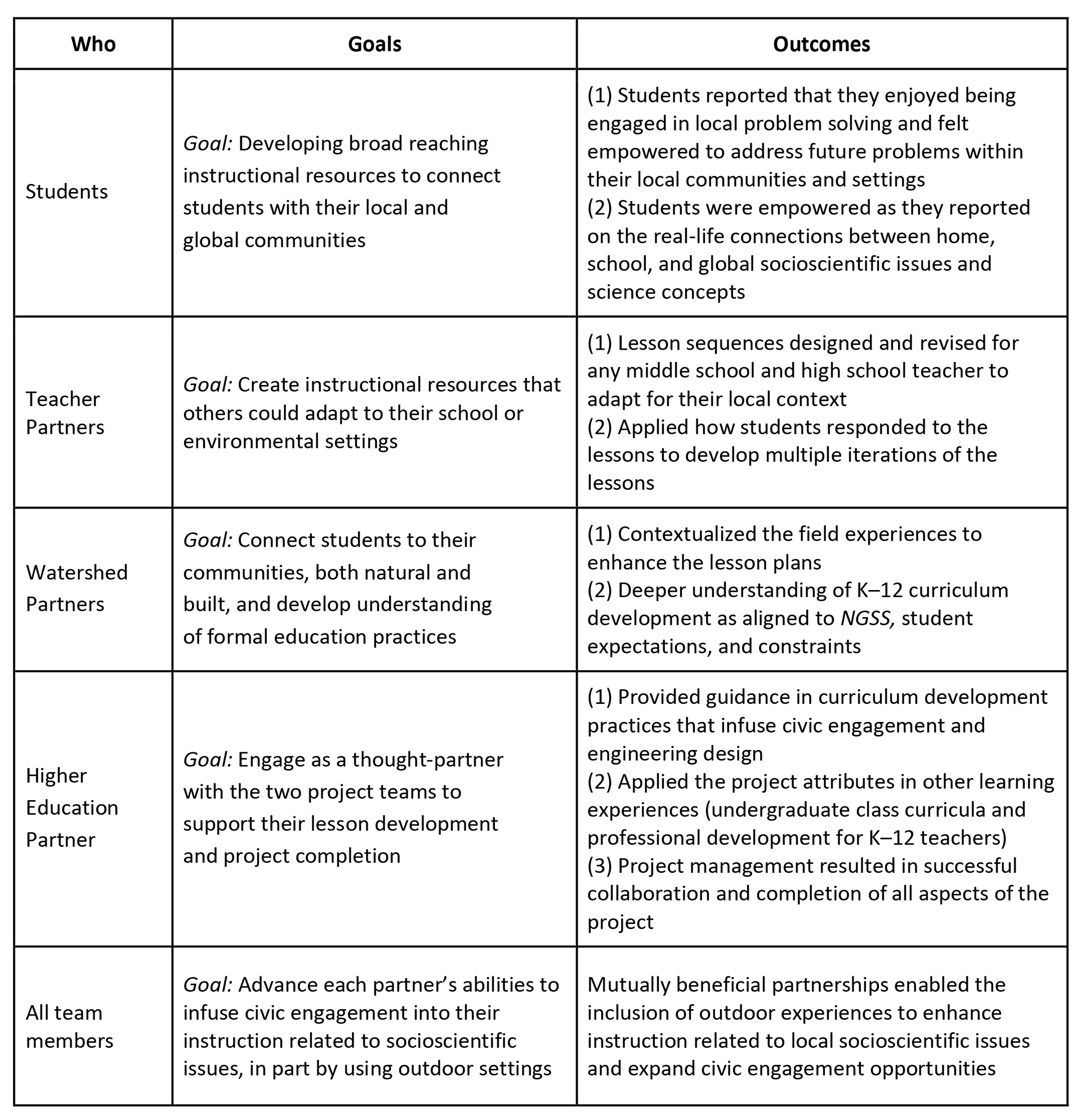
Click here for larger image
Project Design
This project included the co-development and implementation of NGSS-aligned lesson plans (see Supplemental Resources for the middle school and high school lesson plans) between each watershed partner and teacher, field experiences for students, and the presentation of solutions to local stakeholders. The higher-education partner supported the two formal-informal educator teams throughout the entire project.
To start the design work, the two teachers collaboratively designed a comprehensive lesson template based on the work of Moulding et al. (2015) and the 5Es instructional model (Bybee et al. 2006). The template centered on place-based education tenets (Semken et al. 2017) and included NGSS three-dimensional learning components (NGSS Lead States 2013) connected to local environmental issues as referenced in the problem statement in the model lessons (see Supplemental Resources). The sections of the template included enough detail so that the resulting lessons would be turnkey-ready for other educators to adopt.
Using the NGSS 5E lesson template, the lessons were then designed to scaffold students as they learn through the lens of local environmental SSIs connected to the global issues identified in the UN Sustainable Development Goals (United Nations 2015). The engineering design process and practices as outlined in the NGSS were used to frame the tasks for students as they investigated and identified the problem statement, gathered information about current technologies and solutions, designed solutions, and eventually presented their ideas to relevant community stakeholders. Students communicated their solutions to stakeholders, including school administrators and townspeople. By exposing students to natural ecosystems and human impacts on them, students learn about and use NGSS science concepts related to watersheds, water and energy resources, conservation, and human-caused environmental issues as well as aspects of the science and engineering practices.
In the lesson design, the teachers brought deep knowledge about the various standards that could be addressed in the lessons, and their districts’ curricular needs and expectations. The teachers also collaborated with the watershed partners who brought their expertise in outdoor educational experiences and watershed science to the lessons. As the two teams completed the important work of designing new activities and planning logistics, the higher education partner provided oversight of and facilitated all the parts of the project to keep work on track, check in with each partner to make sure they each had what they needed, maintain momentum while also encouraging periodic reflection for an iterative check on goals alignment as well as project outcomes, foster respectful collaborations, and serve as a thought partner for team members.
The project goal of connecting students to their local communities was accomplished with the assistance of watershed partners who identified meaningful field experiences for students. The project team felt field experiences were vital to the success of the project to ensure students were making connections beyond their school walls, and their personal locus. Field experiences raise the probability that students see themselves in a broader context, and therefore, develop civic responsibility and civic action skills (Semken et al. 2017). The two field trips are described in the next section.
Even though the lessons within the project differed for each public-school setting, there were several commonalities in both content and instructional strategies. Both had been designed to engage as many students as possible with the project. The authors want to highlight the level of inclusion within the design of the learning experiences to note that the positive outcomes were representative of the successful experiences of a wide range of learners, including emergent bilingual students, students with learning disabilities, and gifted students across the two diverse school settings (urban middle school and suburban high school). The lesson sequences for each public-school setting provided opportunities for students to work directly with the watershed partners via field trips, videoconferencing, and classroom visits before, during, and after project implementation.
Implementation
Middle school setting
In the urban middle school setting, students evaluated current problems from a local lens by collecting and analyzing data related to energy use, waste production, and water usage in their school. With this local context, they then looked for connections to relevant global issues, and through this process learned broader science concepts. After students investigated ways in which their school was monitoring or minimizing their impacts on the global problems, they designed solutions to one problem they were interested in.
A visit from the watershed partner included a virtual introduction to the watershed facility, including key concepts behind the design of their LEED-certified building and their work with water conservation. Then a smaller group of student volunteers selected as “Science Leaders” (using an interest-based application process) attended an in-person field trip to gather more hands-on experience at the watershed’s environmental education center and shared their learning to peers in their class by sharing what they learned with their groups. These steps exposed students to the additional science background needed, as well as potential strategies to address the conservation issues they identified in their school. Students then considered ways the school community could reduce reliance on fossil fuels, minimize waste, or conserve water before designing unique solutions for helping their school minimize its impact on local and global environments. Finally, students presented their solution (e.g., written policy proposal, 3-D model, poster, etc.)—including the science-based and evidence-based justification on effectiveness—to key stakeholders from the school administration and the watershed organization’s education staff. (See Supplemental Resources for the middle school lesson plan.)
High school setting
In the high school setting, students learned what was meant by “watershed friendly living” as they traced the flow of water from their suburban landscapes into a local wetland, which is part of our US National Wildlife Refuge system. The lesson sequences introduced students to data and data tools to explore their stream dynamics, and they developed and used models to learn about the role of surface type in the quantity of stormwater runoff. After students explored the dynamics of their watershed, they formed small groups, identified potential local impacts on the quality of the water in their watershed, and brainstormed solutions. The watershed partner visited with classes to describe field expectations, including safety in the field, and posed challenging questions for students to explore.
In the field, student representatives from each project team tested the water quality of numerous streams that emptied into the wetland and at one stream where the water emptied out of the wetland. The purpose of the field experience was twofold: (1) intimately engage with their local, built environment and (2) discover the important ecosystem services provided by the wetlands in their local community. The results astonished students as they noticed how the water quality improved as it exited the wetland. This revelation sparked interest in creating a suite of ideas to ensure the water flowing into the wetland is as clean as it could be, so as not to overburden the ecosystem services provided by the wetland. Students designed pamphlets and shared their data-driven ideas with local townspeople such as those on the town environmental commission and school administrators. (See Supplemental Resources for the high school lesson plan.)
The lesson sequences were implemented in the teacher partner’s middle school and high school over three years from 2016 to 2019. The teachers continued with student “Science Leaders” selected from each class to travel to the outdoor site and bring back important findings to their fellow students through “peer instruction.” All middle school classes continued to attend the in-school virtual field trip component to kick off the unit. This allowed the project to continue beyond the initial implementation with colleagues (see Table 2).
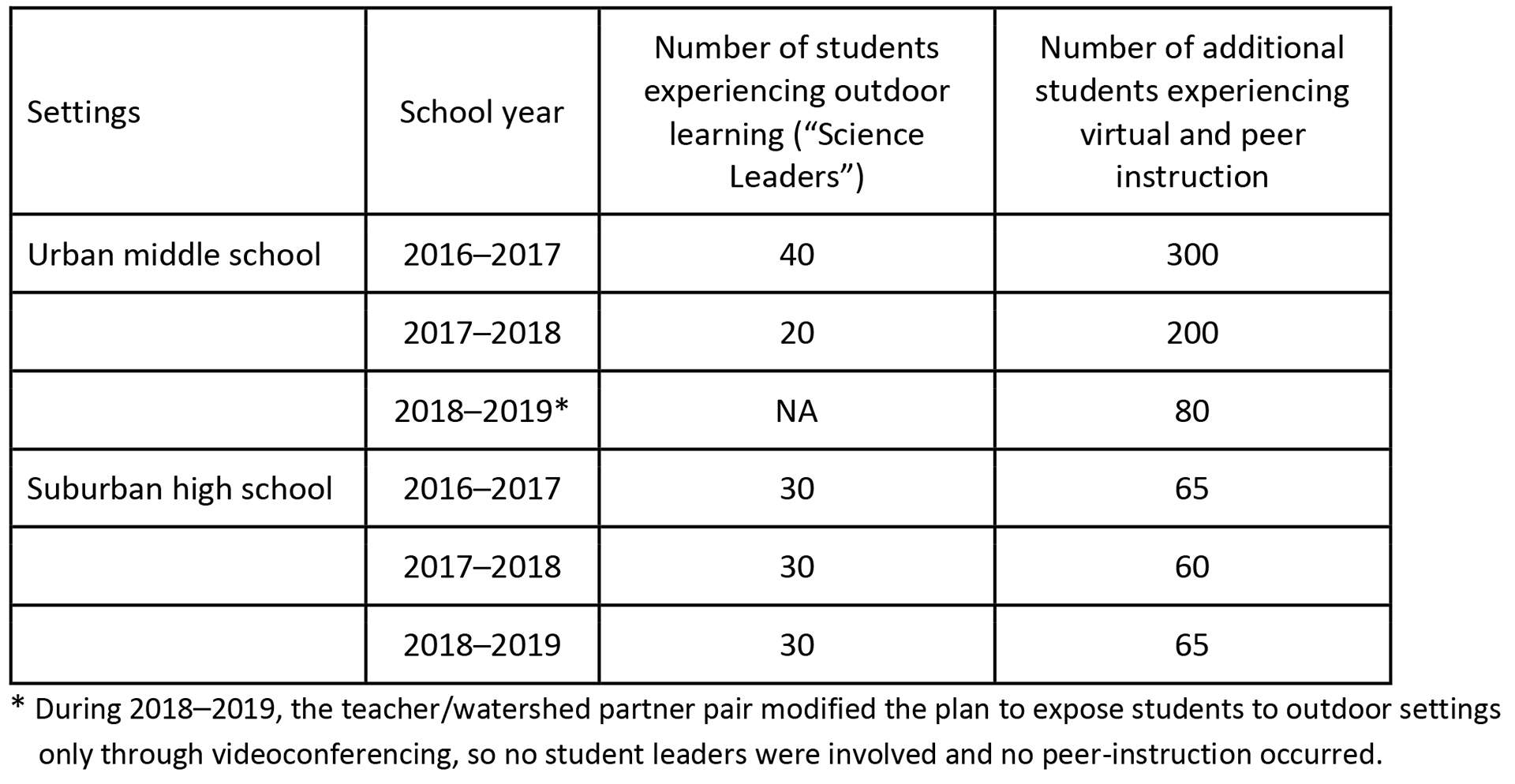
Click here for larger image
Outcomes
As referenced in Table 1, the outcomes for the project included the development of broad-reaching instructional resources and adaptable lesson sequences; connected students with their local and global community through an integrated learning approach that involved outdoor experiences, SSIs, and civic engagement; and advanced mutually beneficial partnerships to achieve the student goals and promote effective curriculum design. The following sections elaborate on these outcomes.
Student outcomes
Both urban middle and suburban high school students learned science through contextualized, local phenomena and issues that had meaning to them. Students reported that they enjoyed being engaged in local problem solving and felt empowered to address future problems within their local communities and settings. The learning outcomes based on the projects completed by the students in the urban middle school inclusion setting indicated that most students could explain how human activities contributed to global issues (lack of water, excessive waste, energy use) as well as connect the “local” visible school issue to the relevant global issue as it pertains to the UN Sustainable Development Goals. Students were able to identify multiple solutions as well as see the linkages between some solutions causing additional problems (e.g., reusable dishware in the cafeteria would cause additional water use). Students also reflected on the real-life connections between home and school related to carbon footprints, water usage, waste production, etc. Some of their strategies and models are illustrated in Figures 1 and 2.
While presenting posters and models to other students and local stakeholders, students summarized the issues with evidence they collected, explained relevant science behind the issue, and proposed an effective solution based on their research.
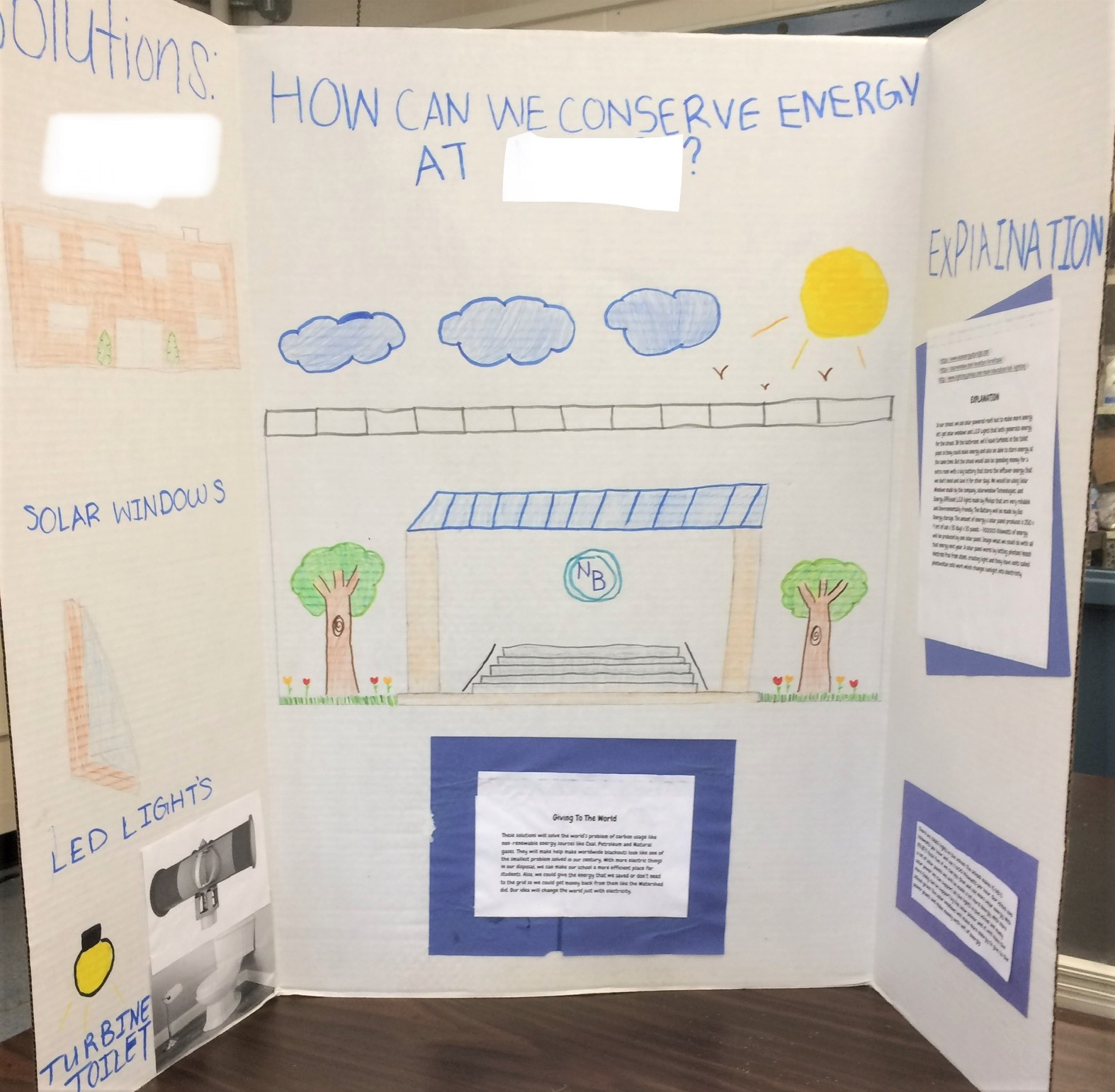
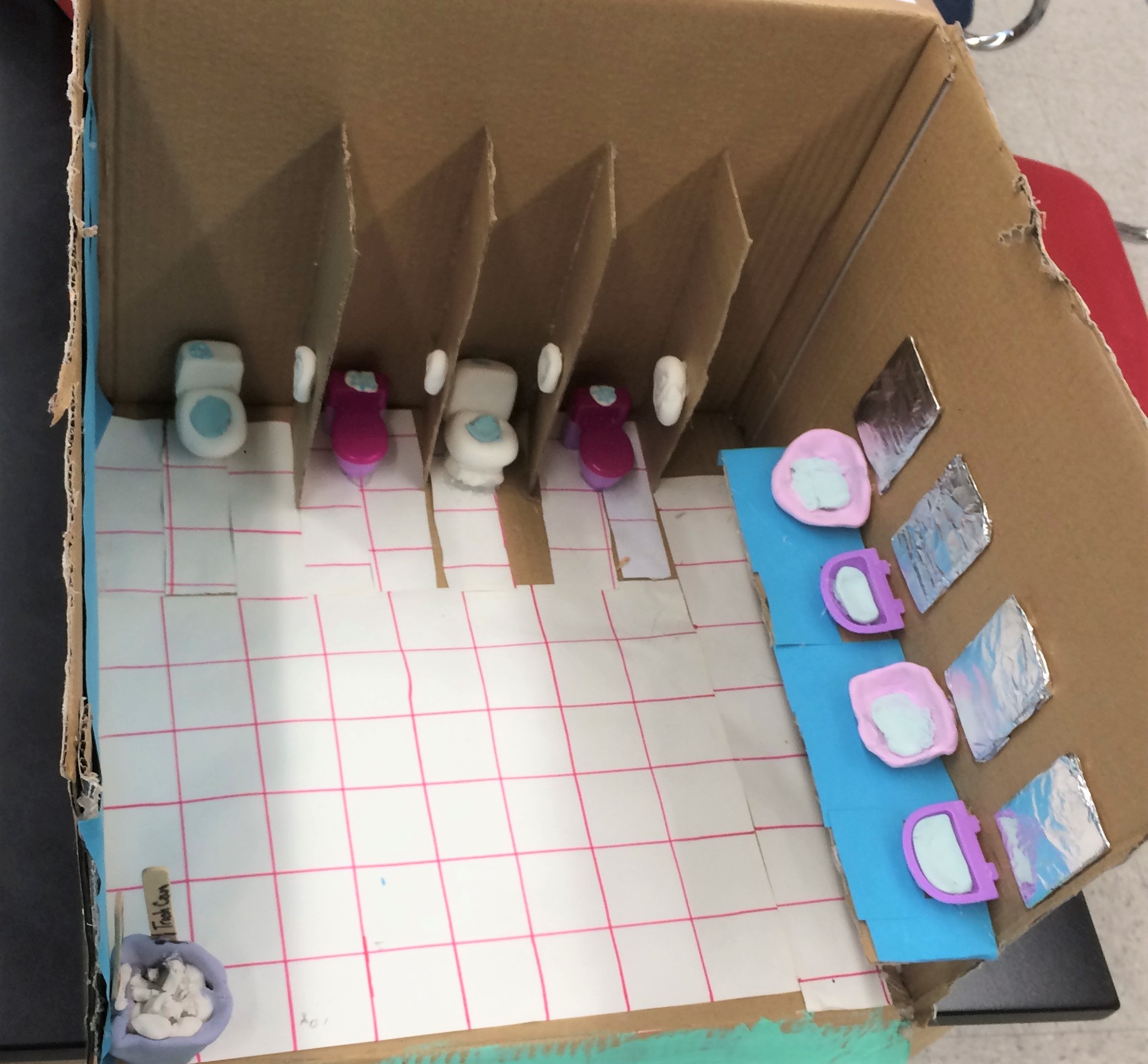
A subset of the middle school students (~100) taught by a co-author completed a survey, self-reporting on the skills they gained from the lessons. Most students reported that they improved their ability to: collaborate with peers (84%); communicate with professional adults (71%); evaluate sources of evidence for quality (60%); and create/evaluate models (64%). The latter two align with student work assessments generally reported here: They struggled to tie evidence to relevant science concepts in their explanations, which provides a good reason to help them with these skills. The students also reported that they struggled with the ability to balance creativity with real-world solutions, a tension that is likely not surprising to teachers incorporating engineering design into their students’ learning.
The high school students' learning outcomes were evident in their solution development and communication in their final projects, which included presentations for local stakeholders and the creation of informative brochures (see Figures 3a and 3b). Using these pamphlets and other materials, student groups presented their evidence to support their claim of the environmental issue they discovered, and the science behind it, and then summarized how and why their solutions could work. Their solutions were peer reviewed and revised before students shared them with a wider audience. Next, they shared their solutions with local environmental commission members and concerned townspeople. The project enabled the teachers and students to make connections with community partners and local government, which were leveraged in successive years of the project. Extremely evident was the development of agency in students as they realized they had a voice and what they had to say mattered when it came to local issues of interest to them.
Teacher outcomes
The teachers involved in the partnership learned throughout the experience as well. The process of designing a lesson template that promotes learning and use of science concepts to address SSIs helped the two teachers prioritize key NGSS standards needed to design instruction for this project. Assessing their students’ learning and observing the students’ participation in the lessons helped them after the first year of implementation refine strategies and enhance areas where students struggled. Collaboration between the teachers resulted in increased motivation, distributed expertise, and enhancement of reflective practices. As they reflected on student experiences, they noted the high engagement, agency, and empowerment observed in their respective students. The opportunity for the peer teachers to discuss these observations and collaborate ensured this was not an individual finding.
Watershed partners’ outcomes
The project and partnerships continued in subsequent years as programming options, which demonstrated the value of the project to the watershed associations. Both watershed partners noted that the experience helped them better understand the NGSS on the planning level as well as the overall vision, which deepened their understanding of formal educators’ needs. The middle school watershed partner indicated that as a result of this project, his organization has shifted to a more adaptable approach to existing program offerings to better meet partner schools’ needs. He also indicated that he is now a practitioner of the NGSS and sees these standards as a common language to accomplish customizations and strong partnerships. Finally, involving so many students, while challenging initially, has now made it much easier to consider doing so in future offerings. The high school watershed partner was able to better engage students in data collection through the experience. She was grateful for the opportunity to connect directly with the next generation of conservationists. The middle school watershed partner noted he was inspired to present remotely during the partnership to address constraints, which was prior to COVID. This allowed him to have a higher comfort and expertise level when offering programs virtually in the coming years. Serving as stakeholders in the solutions design process enabled the watershed partners to see how all parts of the curricula played out for the students and to witness the students’ enthusiasm in the learning.
Higher ed partner outcomes
Observing and facilitating the work for this project provided this partner a window into the work of K–12 teachers who must integrate a variety of school curriculum expectations into accepted and respected instructional strategies to guide all students to learn. As a thought partner, she provided guidance in curriculum development practices that infuse civic engagement and engineering design. The insights she gained in that partnership role influenced the design of her professional development offered and even the revisions of her own course curricula. In addition, the first steps to align goals, define plans for this project, and gain an understanding of each partners’ unique perspectives, expertise, and constraints within their respective educational systems have refined her skills to do this for future projects.
Discussion
Program evaluation
Several strengths of the project were revealed during two evaluators’ discussions with project partners. The project management provided by the higher education partner was an effective support throughout the project as they were able to focus on fostering effective and meaningful collaborations between the two teachers and their respective watershed partners to support the work completed. Each partner reported feeling valued by the other partners for their strengths, expertise, and contributions. A combination of guidance, flexibility, and structure built into the implementation plan was effective for the team to design, implement, and revise curricula developed within an ambitious one-year timeframe. Partners communicated a sense of gratitude for the ongoing commitment of all the project personnel during the project. Providing opportunities to see each partner in their own setting (school or watershed site) as well as outside their setting during team planning meetings aided in the development of a strong, communicative partnership.
Challenges and opportunities
Both teachers identified ways the lessons could be improved to ensure students use science content in their solutions. While the lessons were intentionally designed to support student science learning of explicit disciplinary core ideas and crosscutting ideas (NGSS Lead States 2013), it was challenging for students to integrate them into their explanations without specific probes and prompts. The two teachers, in conversation with the higher education partner, revised the lessons to incorporate purposeful prompts and explicit instruction to support students deepening their connections between the engineering design process and the relevant science ideas.
In the middle school inclusion classroom, students demonstrated success on their solution designs and presentations through their assessments. Accommodations, modifications, and differentiation strategies were used in a co-taught teaching model with a certified special educator to scaffold the process. However, some students were able to identify the connections between school issues and global issues, while others found it challenging. Developing new, innovative solutions that could be effective with justification proved difficult as students were asked to toggle between the abstract and concrete. The level of innovation among the solutions developed by groups varied greatly as a result.
The outdoor and solution-focused experiences for students outweighed the challenges that were encountered. However, there were some logistical challenges worth noting so that others are aware of them should they choose to implement this or a similar project in their settings:
1) Coordinating outdoor field experiences for students includes many aspects of scheduling that must be considered, such as the different professional schedules among partners during the planning phase, identifying timing for trips that aligns with the school calendar and the watershed educators’ availability, and coordinating transportation.
2) In addition, all partners should be informed of and reinforce safety procedures in the field as well as lab safety in the classroom.
3) Often the cost of field experiences is impacted by budgetary restrictions; both the cost of the work on the part of the watershed and transportation must be factored into the planning stage. Using virtual components for meetings during the planning stage and even aspects of the implementation allowed teachers to broaden the scope of the experience at a smaller cost.
Conclusions
We envision that the design of this project, and the experiences implementing it, could inform partnership work across sectors of the K–12 educational system to help students purposefully get outdoors and gain field experience. The benefits of these experiences for students are both abstract and tangible. Students demonstrated key takeaways across both lesson sequences in their understanding that (1) human activities can contribute to global issues; (2) multifaceted solutions are an effective way to meet goals; and (3) relevant scientific connections between home, school, and community are essential to address SSIs. Additionally, students shared their increased comfort level and understanding of how to communicate effective solutions based on evidence-supported arguments with professionals in the field, community, and school district. The joy, motivation, and excitement of being in the field enhanced student experiences in the classroom; however, it is challenging to capture this in tangible ways.
The success of collaboratively developing an in-classroom and out-of-classroom experience depended on the characteristics each project member possessed throughout the project: commitment, vision, respect, and trust. The components of our work that we think were critical to the success of this project include efforts at the start of the project to develop an understanding of individual goals so we could align as many as possible to define the project; regular communications; and one person to coordinate the work, keep track of progress, and facilitate when challenges arise. These steps, we think, helped establish a mutual respect and trust between each member of the team. We hope the benefits of this project will provide an example for ways teachers can explore local partnerships to enhance their students' experience both in and out of the classroom!
Acknowledgments
Please note that each author made substantive intellectual and writing contributions to this article. Therefore, the author order is random, with the submitting author identified first.
Funding for this project was provided through a sub-award from The Institute of Museum and Library Services awarded to the National Center for Science & Civic Engagement (NCSCE) working with the Research Foundation for the State University of New York, Stony Brook (MG-10-15-0071-15A). The grant title: Partnership Champions: SENCER-ISE and Professional Development Through Mentoring to Enhance Learning Environments. The authors would like to thank SENCER-ISE for support, and the ePartnership grant staff and SENCER members for their guidance. We also thank the watershed organizations, Great Swamp Watershed Association (Morristown, New Jersey) and the Watershed Institute (Pennington, New Jersey), for their commitment to and involvement in the project as well as contributing supplemental resources. Finally, we thank the SENCER organization for its longstanding support of instructors to strengthen student learning and interest in STEM topics by connecting course science and math topics to issues of critical local, national, and global importance.
Missy Holzer, PhD, was the high school teacher in this project and is now a Curriculum Designer at Great Minds PBC in Washington, DC. Jessica Monaghan, EdD, was the middle school teacher in this project and is currently the Assistant Director of STEM in the Program in Teacher Preparation at Princeton University in Princeton, New Jersey. Kathleen M. Browne, PhD, was the higher education partner in this project as an Associate Professor in the Department of Earth & Chemical Sciences and is now emeritus professor at Rider University in Lawrenceville, New Jersey.
Environmental Science Lesson Plans STEM Middle School High School Informal Education


